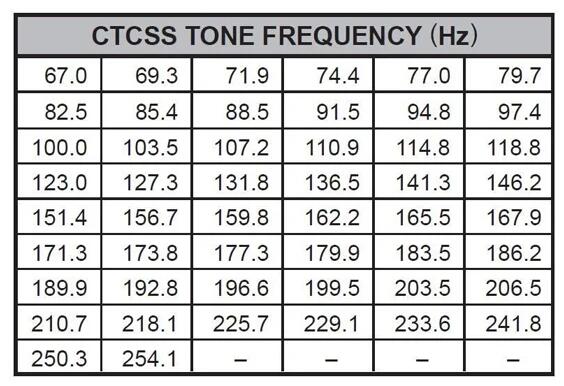WHAT ARE PL TONES / PL CODES?
While many people think PL tones and codes provide some kind of two-way radio encryption, the truth is they do not provide any scrambling, encryption or security advantages. Rather they work like a filter that allows some conversations and radio traffic to be heard while eliminating other traffic coming from people who happen to be using on the same channel and frequency. So, if you have 15 radios using one frequency, but you only want to hear conversations from specific radios, you can use pre-programmed PL tones and codes to filter out unwanted traffic so that you only hear the conversations you want. Technically speaking, PL tones are sub-audible tones that are transmitted simultaneously with the speech portion of the transmission. It is these tones that prevent other people from receiving the transmission.
History of TPL & DPL Codes, and the CTCSS System
The history of PL codes is actually quite interesting. Around the early 1950’s Motorola developed a technology that allowed co-channel users to coexist on the same frequency without having to listen to each other. Once they discovered the technology, Motorola’s legal department immediately patented both the idea and the underlying technology, and trademarked it with its own proprietary name, “Private Line” or PL. The other two-way radio manufacturers understood that these unique PL tones were absolutely necessary to stay competitive, copied the idea and technology, but avoided trademark infringement by coming up with their own term for the same technology:
- General came up with “Channel Guard” or CG
- Ritron used “Quiet Call”
- RCA created “Quiet Channel” or QC
- E.F. Johnson leveraged “Call Guard”
Over the years, however, the original Motorola trademarked term “PL” has become the accepted generic term for the technology despite the herculean efforts by the marketing and legal staffs of the other firms. Eventually the United States Energy Information Administration , which is responsible for analyzing and disseminating energy information to the public, wanted a generic name for the technology and came up with “Continuous Tone Coded Squelch System(CTCSS).
How Many of PL Tones Are There, and What Are Color Dot Frequencies?
Typically, these tones will start at 67 cycles per second or hertz and go as high as 254 htz. Sometimes these are referred to as sub-audible tones or tones that cannot be heard by the human ear. Originally, the mobile radio industry started with 38 sub-audible frequencies, however over the years these frequencies have grown to 50. Top Two-Way Radio repair and service department can easily add PL tones into any RCA or Motorola two-way radio. There is no generic standard tone number assignment or code letter to go with a particular tone; however, below is a chart of the commonly accepted 50 tones used at this time.

In addition to these standard PL tones, there are also “Color Dot” frequencies that can be accessed through business two-way radios. Originally, the “Blue Dot” and “Green Dot” codes were part of the Multi-Use Radio Service (MURS) bands which could be used for both personal and business two-way radio communications. These color dot frequencies are set at 154.570 MHz for blue, and 154.600 MHz for green.
Why Use PL Codes and Tones Why do we use CTCSS tones?
While the use of sharing frequencies by radio users is less common than it once was, there are several reasons why two-way radio users might appreciate CTCSS tones. For example, if there are multiple groups of radios programmed to the same channel, then that channel would have a lot of radio interference making it difficult to communicate directly to a specific receiver without being “stepped on” by other radio users. However, by activating a sub-audible PL tone, the radio receiver will remain off until it hears a signal that was definitely meant to be repeated. One industry that often uses PL tones is the security industry. For example, let’s say a security company needs to monitor a particular frequency 24 hours a day for a specific protection detail. Guards don’t want to be bothered by a random radio call in the middle of the night that’s meant for someone else, right? So many security teams agree to program their radios to transmit a particular CTCSS tone, for example 100 Hz. To keep their receivers from receiving unwanted signals, they would set their PL receive tone for 100 Hz. That way, the group’s receivers will remain silent until a signal shows up with the 100 Hz tone on it.